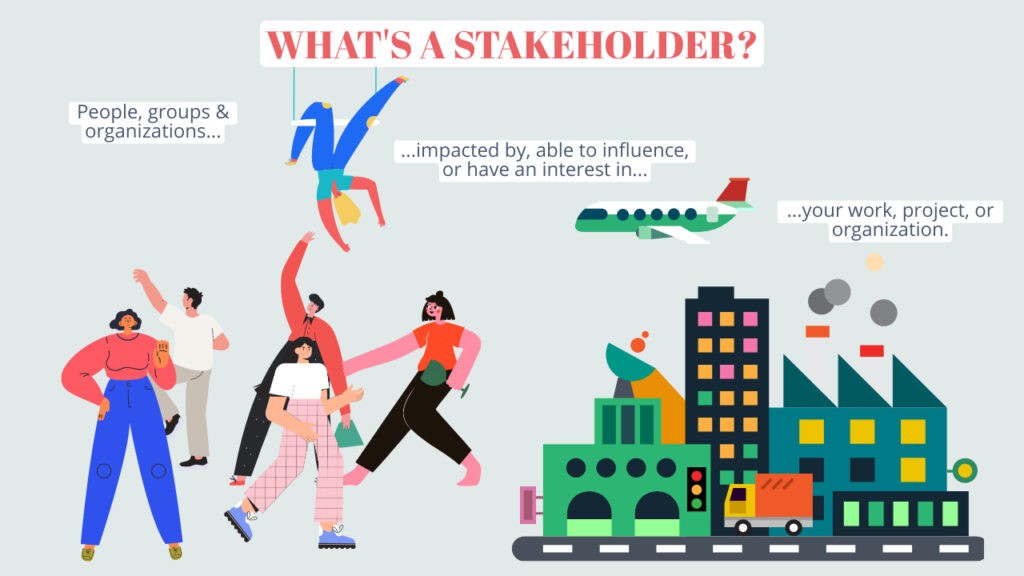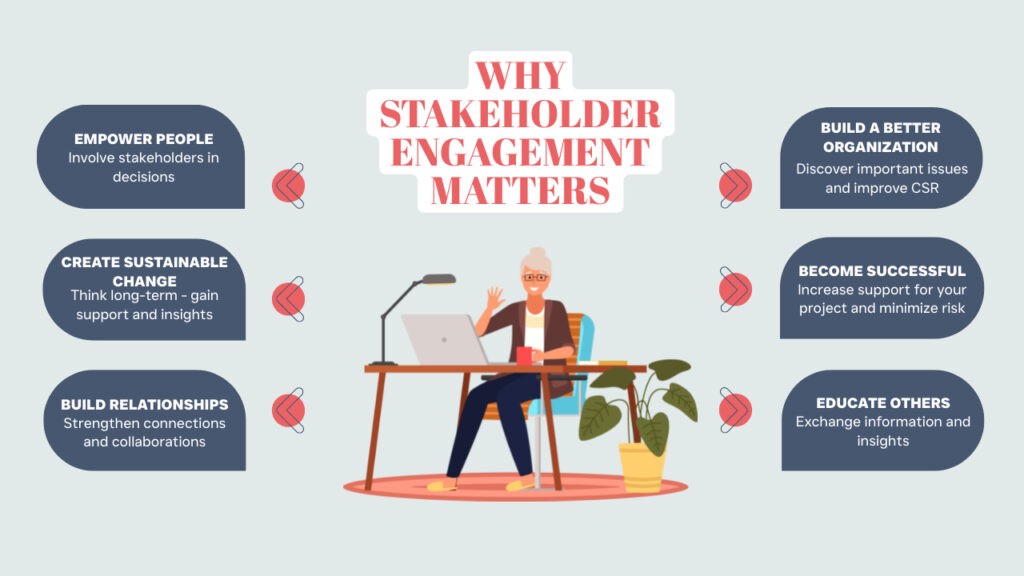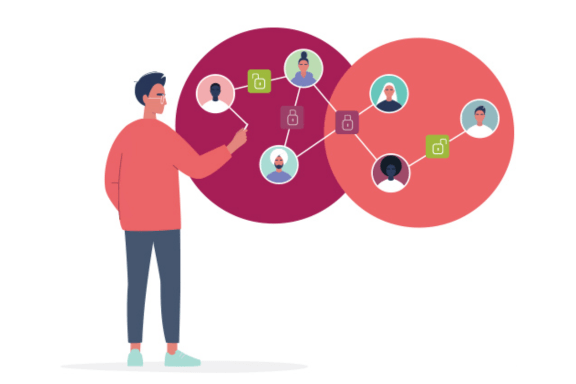The Importance of Stakeholders: Identifying & Prioritizing Stakeholder Engagement

In any organization or business, it’s easy to get swept up in the day to day. You’re likely juggling new projects, customers, clients, services, technologies, objectives and outcomes. But it’s important to realize that the success of your day to day activities depends on one thing: people. In other words, your stakeholders.
So, let’s talk more about the importance of stakeholders, who your stakeholders might be, stakeholder identification methods, prioritizing stakeholder engagement, and some essential tools to help you get it all done.
First up, a definition:
What’s a Stakeholder?

A stakeholder is the people, groups, and organizations that are impacted by, able to influence, or have an interest in your work, project, or organization.
Stakeholders can include customers, employees, community members, politicians, media, shareholders, suppliers, investors, government departments, regulators, neighboring businesses, and nearby residents. Plus all their extended networks of families, friends, and colleagues. These people all:
- Have their own goals and objectives
- Make important decisions that may affect your organization
- Have lives that may be affected by your organization’s decisions
- Are financially or physically better or worse off when things change
- Are connected to a wider network of people who are, in turn, affected by any changes and decisions
So, why are stakeholders important? And why would you want to engage them?
The Importance of Stakeholder Engagement

Don’t underestimate the importance of stakeholders. If you can engage most (or all) of your stakeholders, it can massively benefit both your organization and the people you impact. Specifically, stakeholder engagement can help:
- Empower people – Get stakeholders involved in the decision-making process
- Create sustainable change – Engaged stakeholders help inform decisions and provide the support you need for long-term sustainability
- Build relationships – Create mutually beneficial relationships, build on existing relationships, or foster new ones
- Build a better organization – Engaging with stakeholders can bring important issues to light and encourage your organization to develop corporate social responsibility
- Increase success – Engaging influential groups (who might otherwise hold you back) and turning them into supporters and advocates can boost your chances of success
- Educate – Stakeholders can be a valuable source of information for your organization, and they may learn something from you, as well
In fact, in some cases, such as the engineering project discussed in this research paper, unless nearly all the interested stakeholders feel that the benefits of a proposed project outweigh the perceived risks, the project would not go ahead. Overlooking this (and the importance of involving these stakeholders) may lead to project delays and cancellations that could have otherwise been avoided.
To sum it up, stakeholder engagement can help your organization (and the people around it) achieve better outcomes, whether it’s education, connection, engagement, or profit.
Stakeholders Are More Important Now Than Ever
Organizations haven’t always been so interested in stakeholders. The old way of doing business involved focusing primarily on shareholders and ensuring their interests and needs were met.
But times have changed — and for a good reason. Only delivering value for shareholders led to issues such as poor management, short-term planning, self-interest, and reliance on external regulation.
Today, more organizations aspire to deliver value to all stakeholders (not just shareholders). This has led to healthier, more sustainable, and more innovative companies that take a long-term view, develop strategic relationships, consider social obligations and ethics, and work towards a social license to operate. The end result is companies and projects that are more likely to succeed and do good for society.
The Importance of Stakeholder Identification

If stakeholders are so important, the next question becomes… who are your stakeholders?
The importance of stakeholder identification cannot be overstated. If you know who your stakeholders are, you’ll be in a much better position to manage and engage them, and turn them into advocates and supporters.
In fact, this study looked at whether stakeholders mattered in an organization’s strategic decision making. They found that the success of an organization’s management relies on accurately identifying stakeholders and assessing their relevance so that they can prioritize stakeholders and their involvement in strategic decision making.
There are a lot of different ways to do your stakeholder identification, but usually the best place to start is with a brainstorming session. Ask yourself “what individuals or groups of people are likely to be affected by my organization or project?” and “who might influence the project or organization, or the people involved in it?” and then write down anyone that comes to mind.
From there, expand on each individual or group and map out anyone they’re connected to who might also get the flow-on effects.
It’s normal to start with a list of stakeholders, but then add to it over time — there are usually more potential stakeholders than you think.
Criteria for Stakeholder Importance
Following stakeholder identification, you’ll likely find yourself with a large (and growing) list of stakeholder groups. If you’ve got just a small team to manage them, it can quickly get overwhelming. So, once you’ve identified your stakeholders, it’s a good idea to prioritize them and create a more refined list of key stakeholders.
The importance of stakeholder groups, and the approach you take to engaging each group, will depend on the outcomes you need to achieve and the resources you have available to achieve them.
Depending on your organization, you might focus on the groups most closely connected to your objectives. For example:
- If you’re a business with a goal to increase your profits through a new initiative, your most important stakeholder group will probably be your customers
- If you’re a government organization working on a large development project, your most important stakeholder groups would be those people most likely to oppose your project, as your goal might be to help change their sentiments from negative to neutral or positive.
Stakeholder Analysis & Mapping to Determine Importance
You can use stakeholder mapping to prioritize your stakeholders, typically in conjunction with stakeholder analysis.
One popular stakeholder mapping method involves classifying stakeholders based on their level of influence, impact, and interest (we call this the Three I’s Method).
Another technique worth exploring is relationship mapping. This involves visualizing your stakeholders in the context of their relationships with your organization and with each other. This can help you identify key stakeholders and take a strategic approach as you engage with stakeholders, while building and strengthening your relationships.
After maping your stakeholders, you can develop a stakeholder plan and engagement strategies according to the stakeholder groups you’ve identified.
Finally, note that stakeholder importance can change over time as your project evolves, and as the people involved in and impacted by it also change. So, it’s a good idea to regularly reassess your stakeholders and adapt your approach to ensure you’re still engaging with the right people.
Are Some Stakeholders Really More Important Than Others?
For the most part, organizations assume that some stakeholders are more important than others — and that they must be prioritized and categorized accordingly. However, it is also important that organizations are aware of the limitations to this way of thinking.
This study acknowledges the flaws in stakeholder theory now that stakeholders are more interconnected than ever — and that the way an organization treats even a single stakeholder or small group could have significant and broad impacts.
These days, stakeholder with limited involvement in a project could still make a lot of noise in opposition (or support) via social media, with widespread reach, influencing other stakeholders and even the project itself.
So, although you will likely need to determine stakeholder importance via stakeholder analysis and mapping, don’t overlook the potential of secondary stakeholders — and consider how you may still include them in your engagement, while using your time and resources effectively. For example, you may provide project updates on social media or via an email list that any stakeholder can subscribe to, and you may provide contact information for any stakeholder to share their comments and feedback.
The Importance of a Stakeholder Engagement Tool

If stakeholder engagement is important to you (and it should be), you need a way to manage the process and do it properly. A good tool will quickly deliver an ROI, helping you build and track relationships, keep tabs on how certain people and groups are feeling towards your initiatives and communicate more effectively.
The importance of stakeholder management software will soon be clear from the hours you’ll save each week. Because you’ll claw back so much time, you’ll be able to manage more stakeholders, more effectively, without tying up all your resources.
Essential Tools for Effective Stakeholder Management
Need to invest in or upgrade your stakeholder engagement software? It’s important to be well-informed about what features to look for when comparing your options. In general, we recommend keeping the following features in mind:
- Tracking contact details – Make it easy to see who’s who and know how to reach them quickly
- Tracking communication right across the team – See which people in your organization have been communicating with each stakeholder and what they said (that way, you don’t have to ask them the same questions twice)
- Follow up – Use email integration and task management to ensure no stakeholders slip through the cracks
- Sentiment tracking – See at a glance where stakeholder groups sit on a scale from negative to positive, and track changes to sentiment over time (and do it efficiently using AI)
- Stakeholder mapping – Visualize your data to easily discover who your important stakeholders are based on their relationships, level of impact, level of influence, and other important dimensions
Looking for an efficient tool to track and manage your important stakeholder information? Check out Simply Stakeholders! Our popular stakeholder software has you and your team covered with all the features above and much more, along with a streamlined onboarding process and flexible plans to suit your organization. To get started, learn more about how our software works or book a demo today!
Book a Demo



































